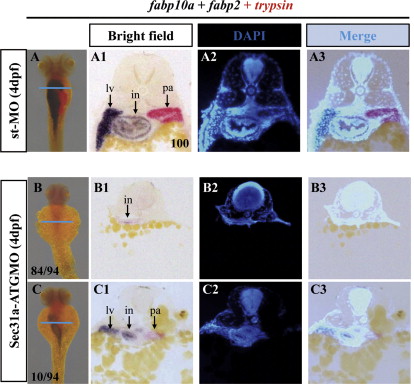Fig. S9 Majority of Sec31a-ATGMO exhibited greatly diminished but not abolished endoderm-derived tissues. (A-C) WISH using Dig-labeled fabp10a and fabp2 (dark blue) and Fast Red-labeled trypsin (red) probes showed that, when compared with that in the control (st-MO) at 4dpf (A), Sec31a-ATGMO morphants were compromised in the development of the digestive organs, with majority (84/94) displayed dramatically diminished organs (B) and the rest (10/94) small organs (C). Cross sectioning of the embryos after WISH (along the blue line as indicated, A1-A3 sections: corresponding to A; B1-B3 sections: to B; C1-C3 sections: to C) showed that the fabp2 positive cells were greatly reduced in number but were not abolished in the type of Sec31a-ATGMO morphants (B).
Reprinted from Developmental Biology, 367(2), Niu, X., Gao, C., Jan Lo, L., Luo, Y., Meng, C., Hong, J., Hong, W., and Peng, J., Sec13 safeguards the integrity of the endoplasmic reticulum and organogenesis of the digestive system in zebrafish, 197-207, Copyright (2012) with permission from Elsevier. Full text @ Dev. Biol.

